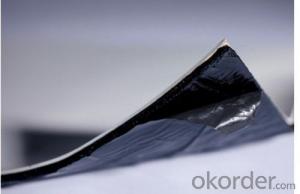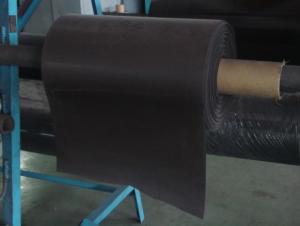EPDM Waterproofing Membrane for Roofing Protection
- Loading Port:
- China main port
- Payment Terms:
- TT OR LC
- Min Order Qty:
- 5000 m²
- Supply Capability:
- 100000 m²/month
OKorder Service Pledge
OKorder Financial Service
You Might Also Like
Product instruction
EPDM waterproof membrane is made from ternary ethylene-propylene rubber. With the best performance among high polymer waterproof materials, EPDM is of exceptional elasticity and will not split or crack under normal building movement.
Detailed Product Description
Product Name: High Polymer Waterproof Membrane
Width of roll: 1m; Thickness : 0.5mm , 1mm , 1.5mm,
Area of roll : 15sq.m , 10sq.m , 7.5sq.m;
Low temperature flexibility : -18/-25
Surfaced materials : PE film , granule, slate , metal foil , sand , mineral and etc;
Applications: Bridge building, storage, road, tunnel, parking station, swimming pool, water-disposal pool, rubbish-disposal places and other waterproofing project, especially for,easy broken structural and cold building protective;
Features
1) Excellent weather-ability, durability and size stability
2) Good adaptability to high and low temperature, UV resistant and anti-corrosion
3) High tensile strength and good elongation, accommodating to structure movement
4) Easy installation, solid joint, and no environmental pollution
5) Good rooting penetration resistance
6) Service life up to 50 years
Application
1) Roofs, Basement, Toilet
2) Industrial and civil building waterproofing
3) Geo-synthetic liner for swimming pool, channels, irrigation system
4) Especially suit for projects with high requirements in durability, anti-corrosion and deformation
Introduction for EPDM Waterproofing Membrane:
Tensile Strength N/CM | Normal temperature: 60 ; 60°C: 30 |
Breaking Elongation % | Normal temperature: 400 ; -20°C: 10 |
Tear Resistance N | 20 |
Impermeability, 30 min no leakage | 0.3Mpa |
Low Temperature Bending °C | -20 |
Heating Shrinking mm | Extension: 2 Shrink: 4 |
Heat Resistance (80°C×168h) | Tensile Strength % : 80 ; Keeping rate of adhesive breaking:70 |
Alkali resistance (10% ca (oh)2 solution,normal temperature ×168h)) | Tensile Strength % : 80 ; Keeping rate of adhesive breaking:80 |
Synthetic aging | Tensile Strength % : 80 ; Keeping rate of adhesive breaking:80 |
FAQ of Waterproofing Membrane
a.Can we get some samples before place order?
Answer: We can send the free samples to you by freight collect.
b.How many years can your PVC membrane guarantee?
Answer: We will guarantee the quality for 5 years at least.
c.Which countries you ever export the product?
Answer: We export the PVC membrane to South Africa, Middle east and even European countries.

- Q:Can a waterproofing membrane be used on galvanized surfaces?
- Yes, a waterproofing membrane can be used on galvanized surfaces. Galvanized surfaces are typically used to protect metal from corrosion, and applying a waterproofing membrane can further enhance the protective properties of the galvanized coating. The membrane can provide an additional layer of defense against water penetration, preventing moisture from reaching the galvanized surface and potentially causing rust or other damage. However, it is important to ensure that the waterproofing membrane is compatible with the galvanized surface and is specifically designed for use in such applications. It is also recommended to consult with the manufacturer or a professional to ensure proper installation and compatibility before applying a waterproofing membrane on galvanized surfaces.
- Q:Are waterproofing membranes suitable for historical buildings?
- Under certain circumstances, historical buildings can benefit from the use of waterproofing membranes. These membranes are specifically designed to safeguard structures against water damage, which is especially important for historical buildings that may have aged and porous materials. However, the suitability of waterproofing membranes for historical buildings relies on a variety of factors. First and foremost, it is vital to take into account the unique requirements and characteristics of the historical building in question. Each building possesses distinct materials and features, and the impact of waterproofing on these elements must be thoroughly assessed. Some older structures may possess delicate architectural elements or materials that could be adversely influenced by the application of waterproofing membranes. In such instances, alternative methods that are less intrusive or damaging may be more appropriate. Secondly, it is essential to seek guidance from conservation experts or professionals who specialize in the preservation of historical buildings. These experts can evaluate the specific needs of the building and offer advice on the most suitable waterproofing techniques. They can also ensure that any interventions are executed in a manner that respects the historical integrity and authenticity of the structure. Lastly, it is crucial to consider the long-term consequences of waterproofing membranes on historical buildings. While these membranes can effectively protect against water damage, they may also compromise the natural breathability of the building, potentially leading to moisture accumulation and further deterioration. Therefore, it is imperative to carefully balance the benefits of waterproofing with the potential risks and long-term effects. In conclusion, while waterproofing membranes can be appropriate for historical buildings, caution should be exercised when applying them. A thorough assessment of the building's specific requirements, consultation with preservation experts, and consideration of long-term implications are essential in determining the suitability of waterproofing membranes for historical structures.
- Q:Can a waterproofing membrane be used for modular buildings or container homes?
- Yes, a waterproofing membrane can be used for modular buildings or container homes. These structures often have unique challenges when it comes to waterproofing due to their modular construction and potential for water ingress at joints and connections. A waterproofing membrane can effectively seal these areas, preventing leaks and water damage. It can be applied to the exterior walls, roof, and foundation of the structure, providing a durable and long-lasting waterproof barrier. Additionally, a waterproofing membrane can be customized to meet the specific requirements of modular buildings and container homes, ensuring optimal protection against water infiltration.
- Q:Can a waterproofing membrane be used for seawalls or bulkheads?
- Yes, a waterproofing membrane can be used for seawalls or bulkheads. Waterproofing membranes are designed to provide a barrier against water penetration and can be applied to various structures, including seawalls and bulkheads. These membranes are typically made of materials such as bitumen, rubber, PVC, or polyurethane, which offer excellent resistance to water and ensure the structural integrity of the wall or bulkhead. The membrane is applied to the surface of the structure, forming a continuous and durable waterproof layer that prevents water from seeping through. This helps protect the seawall or bulkhead from erosion, corrosion, and other forms of damage caused by exposure to seawater. Additionally, waterproofing membranes can also provide additional benefits such as increased durability, improved aesthetics, and enhanced resistance to UV rays and chemicals. Overall, the use of a waterproofing membrane is an effective solution for ensuring the long-term performance and durability of seawalls and bulkheads in marine environments.
- Q:Can a waterproofing membrane be used in areas with heavy foot traffic or vehicle loadings?
- In high-traffic or heavy loading areas, it is possible to utilize a waterproofing membrane. Nevertheless, it is crucial to select a membrane specifically designed for such purposes in order to guarantee durability and longevity. These specialized membranes are typically thicker and more resistant to wear and tear. Furthermore, it is important to consider the type of traffic or loading that the area will endure. For instance, areas with vehicular traffic may necessitate a membrane with higher compressive strength to endure the weight of vehicles. In conclusion, the selection of the appropriate type of membrane that satisfies the specific demands of the application is of utmost importance when using waterproofing membranes in high-traffic or heavy loading areas.
- Q:Can a waterproofing membrane be used on underground structures?
- Yes, a waterproofing membrane can be used on underground structures. In fact, it is a common practice to apply waterproofing membranes to underground structures such as basements, tunnels, and underground parking garages. These membranes are designed to prevent water infiltration and protect the structure from water damage. They are typically made of materials such as bitumen, EPDM, or PVC and are applied to the exterior walls or floors of the underground structure. The waterproofing membrane acts as a barrier, preventing water from seeping into the structure and causing issues such as dampness, mold growth, or structural damage. Additionally, waterproofing membranes can also help to reduce the risk of leaks, improve the overall lifespan of the underground structure, and enhance its durability. Therefore, using a waterproofing membrane on underground structures is highly recommended to ensure their long-term integrity and functionality.
- Q:Can a waterproofing membrane be used in conjunction with other waterproofing products?
- Yes, a waterproofing membrane can be used in conjunction with other waterproofing products. In fact, it is often recommended to use multiple waterproofing methods or products together for enhanced protection against moisture and water damage.
- Q:Can a waterproofing membrane be used on copper surfaces?
- Yes, a waterproofing membrane can be used on copper surfaces.
- Q:Roof SBS waterproofing membrane additional layer needs to be wide
- The waterproofing membrane is a curlable sheet-like waterproofing material. Is one of the important varieties of waterproofing materials in construction engineering. According to the brand classification Construction industry waterproofing membrane mainly Dike waterproof membrane, DuPont waterproofing membrane, Sicon waterproofing membrane, which the first two participating GB chart set. According to its main waterproof composition material can be divided into asphalt waterproof material, high polymer modified waterproof membrane and synthetic polymer waterproofing membrane (SBC120 polyethylene polypropylene composite membrane) three categories. There are PVC, EVA, PE, ECB and other waterproofing membrane
- Q:Are waterproofing membranes resistant to hydrostatic pressure?
- Yes, waterproofing membranes are designed to be resistant to hydrostatic pressure.
1. Manufacturer Overview |
|
|---|---|
| Location | |
| Year Established | |
| Annual Output Value | |
| Main Markets | |
| Company Certifications | |
2. Manufacturer Certificates |
|
|---|---|
| a) Certification Name | |
| Range | |
| Reference | |
| Validity Period | |
3. Manufacturer Capability |
|
|---|---|
| a)Trade Capacity | |
| Nearest Port | |
| Export Percentage | |
| No.of Employees in Trade Department | |
| Language Spoken: | |
| b)Factory Information | |
| Factory Size: | |
| No. of Production Lines | |
| Contract Manufacturing | |
| Product Price Range | |
Send your message to us
EPDM Waterproofing Membrane for Roofing Protection
- Loading Port:
- China main port
- Payment Terms:
- TT OR LC
- Min Order Qty:
- 5000 m²
- Supply Capability:
- 100000 m²/month
OKorder Service Pledge
OKorder Financial Service
Similar products
New products
Hot products
Related keywords



























